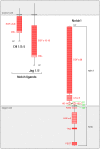Notch signaling in glioblastoma: a developmental drug target?
- PMID: 21078177
- PMCID: PMC2996337
- DOI: 10.1186/1741-7015-8-72
Notch signaling in glioblastoma: a developmental drug target?
Abstract
Malignant gliomas are among the most devastating tumors for which conventional therapies have not significantly improved patient outcome. Despite advances in imaging, surgery, chemotherapy and radiotherapy, survival is still less than 2 years from diagnosis and more targeted therapies are urgently needed. Notch signaling is central to the normal and neoplastic development of the central nervous system, playing important roles in proliferation, differentiation, apoptosis and cancer stem cell regulation. Notch is also involved in the regulation response to hypoxia and angiogenesis, which are typical tumor and more specifically glioblastoma multiforme (GBM) features. Targeting Notch signaling is therefore a promising strategy for developing future therapies for the treatment of GBM. In this review we give an overview of the mechanisms of Notch signaling, its networking pathways in gliomas, and discuss its potential for designing novel therapeutic approaches.
Figures


References
-
- Ohgaki H, Kleihues P. Population-based studies on incidence, survival rates, and genetic alterations in astrocytic and oligodendroglial gliomas. J Neuropathol Exp Neurol. 2005;64:479–489. - PubMed
-
- Newton HB. Primary brain tumors: review of etiology, diagnosis and treatment. Am Fam Physician. 1994;49:787–797. - PubMed
-
- Ohgaki H, Dessen P, Jourde B, Horstmann S, Nishikawa T, Di Patre PL, Burkhard C, Schuler D, Probst-Hensch NM, Maiorka PC, Baeza N, Pisani P, Yonekawa Y, Yasargil MG, Lütolf UM, Kleihues P. Genetic pathways to glioblastoma: a population-based study. Cancer Res. 2004;64:6892–6899. doi: 10.1158/0008-5472.CAN-04-1337. - DOI - PubMed
Publication types
MeSH terms
Substances
LinkOut - more resources
Full Text Sources
Other Literature Sources

